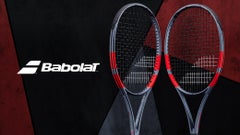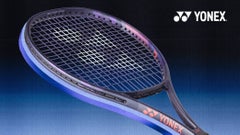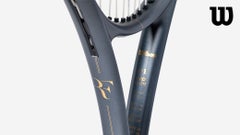Choosing The Right Tennis String
Each tennis string comes with specific benefits that help optimise your tennis racquets performance. Here is our handy guide to the most important benefits that strings can offer.
Power
If your shots are landing short and you're having a hard time generating the needed power for pressuring your opponent or hitting winners, a more powerful string can help. A good rule of thumb for finding a more powerful string boils down to three words: softer is better. For this reason, the most powerful strings come from the two softest string types, natural gut and multifilament.
LEARN MORE: OUR PICK FOR BEST POWER STRING
Insider tip for advanced players
For the big swinging polyester user / string breaker who wants extra power but also requires durability, we recommend going with a softer polyester string. This class of polyester strings (typically called “co-polys” or “co-polyesters”) have excellent durability while deploying additives to increase power. Not recommended for beginners.
Control
If you’re having trouble keeping the ball inside the lines or placing your shots effectively, a control string can help. The magic ingredient of control is a high stiffness level, which is why the best control strings come from the polyester category. Firm polyester strings not only produce more manageable ball speeds and shot trajectories, they also help in the generation of spin, which enables the player to bring the ball down with a high degree of precision. Not recommended for beginners.
LEARN MORE: OUR PICKS FOR BEST CONTROL STRINGS
Insider tip for beginners
If you’re hitting too many balls long and you’re not ready for a stiff polyester control string, you can get extra control through higher string tensions and thicker gauges.
LEARN MORE: STRING BASICS
LEARN MORE: HOW TO CHOOSE TENSION
Spin
If you’ve ever witnessed the sharp angle of a Rafael Nadal passing shot or the way his high arching shots drop suddenly inside lines and explode past his opponents, you have witnessed the magic of spin. However, spin isn’t exclusive to the world’s top players. It is necessary for controlling shot trajectory and creating a safe margin of error when attempting to clear the net. It will also help you bring the ball down effectively when swinging for power. As with control, the best spin strings come from the polyester family.
LEARN MORE: OUR PICKS FOR BEST SPIN STRINGS
Insider tip for beginners
If you're looking to add some topspin to your game, you don’t need a stiff polyester. You can get extra spin through higher string tensions, which will give you the needed control to execute topspin mechanics, i.e., taking bigger upward cuts at the ball.
Comfort
Although tennis is not considered a brutal sport, every hitting session is marked by the repetitive and violent collision between ball and strings, the outcome of which travels straight to your arm in the form of vibration and shock. For this reason the need for comfort is paramount for a great many players, especially beginners with lighter racquets and unpolished technique but also any player who has experienced tennis elbow. The best comfort strings come from the natural gut and multifilament families as their pliability is essential for absorbing impact shock.
Insider tip for advanced players
For the big swinging polyester user / string breaker who wants extra comfort but also requires durability, we recommend going with a softer polyester string. This class of polyester strings (typically called “co-polys” or “co-polyesters”) have excellent durability while deploying softening agents for greater comfort. Not recommended for beginners.
Durability
Nothing lasts forever, including tennis strings. They will eventually break due to blunt impact force and/or the frictional wear caused by string movement. Although these problems are a much bigger concern for experienced players with long, fast strokes, no player is immune to string breakage. As with the control and spin categories, the best durability strings come from the polyester family, which has long been the most popular refuge for chronic string breakers.
Insider tip for beginners
If you’re looking for a more durability without having to switch to a stiff polyester, we recommend using a synthetic gut or multifilament with a thicker gauge (15, 15L or 16).
Hybrid
Tennis strings almost always come with tradeoffs. If you want the plush comfort and raw power of natural gut, you typically have to give up some control and spin. On the other hand, if you crave the precision and durability of a stiff polyester, you usually have to sacrifice some comfort and power. However, if you want a string that delivers the best of both worlds, then you should try a hybrid. Hybrids combine two different string types (one for the vertical mains, the other for the horizontal crosses) to give you an expanded range of playbility.







